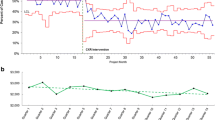Abstract
In the administrative and clinical functions of healthcare delivery organizations, integrated information technology systems are a relatively recent development. Over the past decade, spurred by a federal incentive program, the electronic health record and enterprise-wide information technology have been implemented in almost all hospitals, health systems and physician’s offices in the US. As a result, current and aspiring healthcare administrators have access to a wealth of data and information that was previously elusive. In order to gain maximum management benefit from data and analytics, those in administrative positions require competence in using the technology and in accessing the insight that data analytics delivers to their desks. To this end, undergraduate and graduate programs in healthcare administration across the country have rapidly adapted to curriculum changes that address the educational needs of their students who are on career paths to serve in healthcare management positions. The evolution of curriculum changes in the last decade began with integration of health IT content into various courses in non-IT disciplines (e.g. finance). Subsequently, programs developed dedicated courses in health IT and analytics, and more recently some have begun to offer advanced degree programs that concentrate on electronic information, data and analytics. Health IT systems have the potential to offer as yet untapped support for clinical and management advances. In the US, undergraduate and graduate programs in healthcare management face the same challenges and promise as the future holds for healthcare delivery systems and physicians and researchers. In response, higher education programs in healthcare administration can be expected to continue to evolve as the demands of the IT field evolve. This chapter describes the health IT resources and programs available to healthcare management programs.
Access this chapter
Tax calculation will be finalised at checkout
Purchases are for personal use only
Similar content being viewed by others
References
Office of the National Coordinator for Health Information Technology (June 17, 2019) Quick Stats. https://dashboard.healthit.gov/quickstats/quickstats.php. Accessed September 20, 2019.
Yaraghi N. Hackers, phishers, and disappearing thumb drives: Lessons learned from major health care data breaches. Center for Technology Innovation at Brookings. May 2016. https://www.brookings.edu/wp-content/uploads/2016/07/Patient-Privacy504v3.pdf. Accessed January 24, 2020.
Bresnick J. Top 12 artificial intelligence innovations disrupting healthcare by 2020. April 11, 2019. https://healthitanalytics.com/news/top-12-artificial-intelligence-innovations-disrupting-healthcare-by-2020. Accessed January 24, 2020.
Deloitte. Digital therapeutics: improving patient outcomes through convergence. 2019. https://www2.deloitte.com/content/dam/Deloitte/us/Documents/life-sciences-health-care/us-lshc-digital-therapeutics.pdf. Accessed January 24, 2020.
Krawiec RJ, Housman D, White M, Filipova M, et al. Blockchain: Opportunities for Health Care. Deloitte. Aug 2016. https://www2.deloitte.com/content/dam/Deloitte/us/Documents/public-sector/us-blockchain-opportunities-for-health-care.pdf. Accessed January 24, 2020.
Centers for Medicare and Medicaid Services. National Health Expenditure Data: Historical. 2019. https://www.cms.gov/Research-Statistics-Data-and-Systems/Statistics-Trends-and-Reports/NationalHealthExpendData/NationalHealthAccountsHistorical.html. Accessed September 20, 2019.
Association of University Programs in Health Administration. Vision, Mission, Values. 2016. https://www.aupha.org/about/visionmissionvalues. Accessed November 1, 2019.
Association of University Programs in Health Administration. HIMSTA Curriculum. 2012. https://network.aupha.org/himstacurriculum. Accessed November 1, 2019.
University of Alabama at Birmingham, Department of Health Services Administration, Health Informatics. 2019. https://www.uab.edu/shp/hsa/graduate/mshi. Accessed September 29, 2019.
University of Alabama at Birmingham, Department of Health Services Administration, Health Informatics. 2019. https://www.uab.edu/shp/hsa/graduate/residential-msha/dual-degrees-certificates. Accessed September 29, 2019.
University of Central Florida, Department of Health Management and Informatics. 2019. https://ccie.ucf.edu/hmi/programs/hci/faqs/. Accessed October 20, 2019.
George Washington University, Online Master of Science (M.S.) in Management Health Informatics and Analytics. 2019. https://publichealthonline.gwu.edu/health-informatics/. Accessed September 29, 2019.
American College of Healthcare Executives. 2019. https://www.ache.org/about-ache. Accessed October 24, 2019.
HIMSS Frequently Asked Questions. 2019. https://www.himss.org/himss-faqs. Accessed October 24, 2019.
College of Healthcare Information Management Executives. 2019. https://chimecentral.org/about/history-mission/. Accessed October 24, 2019.
American Public Health Association. Health Informatics Information Technology. 2019. https://apha.org/apha-communities/member-sections/health-informatics-information-technology. Accessed November 3, 2019.
CAHME Mission Statement. 2018. https://cahme.org/healthcare-management-education-accreditation/why-cahme/. Accessed August 15, 2019.
AUPHA Criteria for AUPHA Undergraduate Certification. 2017. https://higherlogicdownload.s3.amazonaws.com/AUPHA/5c0a0c07-a7f7-413e-ad73-9b7133ca4c38/UploadedImages/Certification/Guidelines_for_Undergraduate_Certification_rev_2017.pdf. Accessed August 14, 2019.
CAHIIM History. 2019. https://www.cahiim.org/about-us/history. Accessed August 14, 2019.
Cosgrove D. A CEO checklist for high-value health care. 2012. www.iom.edu/Global/Perspectives/2012/CEOChecklist.asp
Land T. Powering up with technology to deliver transformative care and lower costs. Front Health Serv Manag. Spring 2018;34:3. p. 1–2 https://journals.lww.com/frontiersonline/Fulltext/2018/03000/Powering_Up_with_Technology_to_Deliver.1.aspx. Accessed January 20, 2020.
Author information
Authors and Affiliations
Editor information
Editors and Affiliations
Rights and permissions
Copyright information
© 2020 Springer Nature Switzerland AG
About this chapter
Cite this chapter
Schulte, M. (2020). Informatics Education for Health Administrators. In: Berner, E.S. (eds) Informatics Education in Healthcare. Health Informatics. Springer, Cham. https://doi.org/10.1007/978-3-030-53813-2_8
Download citation
DOI: https://doi.org/10.1007/978-3-030-53813-2_8
Published:
Publisher Name: Springer, Cham
Print ISBN: 978-3-030-53812-5
Online ISBN: 978-3-030-53813-2
eBook Packages: MedicineMedicine (R0)




